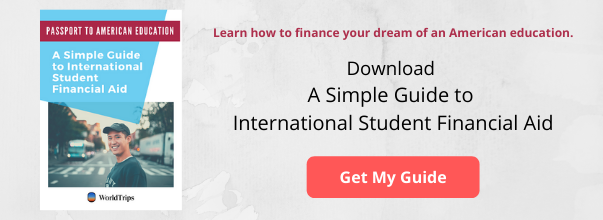It's easy to dismiss your dream of pursuing a college education in the United States- after all, the prospect of traveling to the U.S. for an international study program can seem financially daunting, if not downright impossible.
But a strategy that combines financial aid, scholarships, and/or loans with personal savings and realistic decision-making is a solid approach that can make your dreams come true. With careful planning and the following tips, you can find ways to cut the cost of your college education in America.
Can You Afford to Study in the United States?
Whether you've always planned on getting your degree in the United States or you're simply entertaining the idea of studying abroad, you will need to keep costs in mind throughout every step of your research.
As a college student, you will have numerous expenses, which include tuition, room and board, food, health insurance, books and supplies, transportation, and personal expenses. As such, it may not be the wisest decision for you to pursue an expensive private or Ivy League school.
There are over 2,900 four-year colleges and universities in the United States, and many are well respected throughout the world due to histories of strong research and specialized academic programs. A school you may never have heard of might have one of the top programs for your field, so research is key. Keep in mind, however, that fees for the most prestigious public universities may be just as high as those in the private sector.
According to Top Universities, the following average fees applied to U.S. universities for the 2014-2015 academic year:
Public Four-Year College (out-of-state):
- Tuition and Other Fees: $22,958
- Room and Board: $9,804
- Total: $32,762
Private Non-Profit Four-Year College:
- Tuition and Other Fees: $31,231
- Room and Board: $11,188
- Total: $42,419
When transport and other living expenses are factored in, College Board estimates the following annual expenses for undergraduate students in America in the 2014-2015 academic year:
Public Four-Year College (out-of-state):
- Total: $37,229
Private Non-Profit Four-Year College:
- Total: $46,272
5 Ways to Pay for Your U.S. Education
It is vital that you begin conducting your research early, as many scholarships have application deadlines very early in the school calendar.
You'll also need to contact any schools in which you are interested to learn about your financial aid options and any scholarships available to international students. While many schools offer some form of financial aid, not all types are open to foreign scholars.
Still need help? Here are 5 tips for financing your college education:
1. Use Your Savings
Scholarship awards, if available, will fund only a portion of the tuition and living costs for your first year as an international student, and some schools even require international students to prove that they have sufficient funds to cover tuition before they can enroll.
According to the Institute of International Education (IIE), in the 2012-2013 school year, approximately 64 percent of international students used personal and family funds as their primary source of financial support for their tuition at an American university.
Many students also engage in crowdfunding or fundraising activities to help earn money for their educations.

2. Apply for Scholarships
Whether you are able to receive or even apply for a specific scholarship depends entirely on the basis of the scholarship itself. Some scholarships are merit-based, which typically means that they are annual, competitive scholarships based on high achievement and extracurricular involvement.
Other scholarships are need-based and applied when an applicant meets certain financial criteria. The university or organization granting a need-based scholarship will likely ask for a summary of your financial status and award money based on your ability to pay for your education.

*There are other various types of scholarships (based on heritage, field of study, etc.) which you can see here.
3. Apply for Financial Aid
In the 2012-2013 academic year, approximately 21% of international students received financial aid from an American school, 7% received aid from a foreign government or university, and 5% received funding from employers.
Financial aid is need-based and can include both loans and money for tuition and other college-related expenses. It will require proof of your family's income as part of your application, and you should be prepared to supply your U.S. institution's financial aid office with tax documents, bank statements, and other official financial records.
Though most financial aid in the United States is restricted to United States citizens, legal residents, and green card holders, there are still financial aid opportunities available to international students, so be sure to start researching early and contact schools with any financial aid questions.

*For 10 questions you should ask your college about financial aid, check out this guide to international student financial aid.
4. Work a Part-Time Job
Many international students find that a job is essential in helping them pay for all of their personal expenses that arise throughout each year.
While you cannot work a full-time job as an international student, due to U.S. immigration regulations, you may work up to 20 hours per week- on campus- during your first college year.
In your second year of study, U.S. regulations will allow you to apply for permission to work off campus for up to 20 hours a week. Keep in mind that the request to work off campus is not always granted.
On-campus jobs available to international students include positions in the school cafeteria, bookstore, library, or gymnasium. Though it is unlikely that you will be able to earn enough money to pay for the bulk of your expenses, you should be able to generate money to cover books, clothing, and personal expenses.

5. Apply for a Loan
Private student loans are available to international students, though it is best to fund your education with as many scholarships and as much financial aid as possible in order to avoid high loan repayment rates.
While loans are not ideal, they are sometimes unavoidable. Before applying for a loan, be sure to determine how much money you can put forth in personal savings and how much scholarship money you will be receiving toward your education. A loan should be the last piece you add to your overall budget.

*To learn how to apply for and repay a student loan, check out this guide to international student financial aid.
Top Scholarships for International Students
While some scholarships are merit based or need based, others are based on community volunteerism, field of study, heritage, or a number of other factors. Take advantage of sites that allow you to search for specific scholarships based on filters like scholarship name, field of study, location of study, and home country.
Remember that researching scholarships, requesting information, acquiring necessary documents, and completing applications takes time, so start the process well before your scholarship application deadlines. Before you begin, be sure to check out these scholarship application tips!
Here are some of the major scholarships available to international students pursuing graduate studies:
Fulbright Scholarships
Since its inception in 1946, the Fulbright Program has been considered "the flagship international educational exchange program sponsored by the U.S. Government." The Fulbright Foreign Student Program, in particular, allows international graduate students, young professionals, and artists to study and conduct research in the United States. It operates in over 160 countries worldwide, awarding approximately 4,000 scholarships to foreign students each year.
AAUW International Fellowships
The AAUW (formerly known as the American Association of University Women) awards fellowships to international women coming to the United States to study or research full time at the graduate or postgraduate level. The association awards a total of $18,000 for master's degrees, $20,000 for doctoral degrees, and $30,000 for postdoctoral studies.
Aga Khan Foundation International Scholarship Programme
The Aga Khan Foundation, a private non-profit international development agency, provides annual scholarships for postgraduate studies to outstanding students from select developing countries who have no other means of funding their postgraduate educations. Scholarships are provided on a 50% grant/50% loan basis, and the application process is very competitive.






